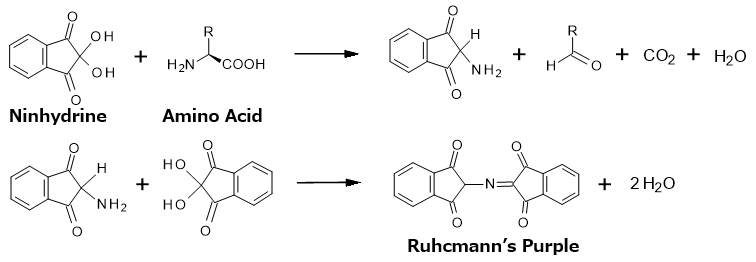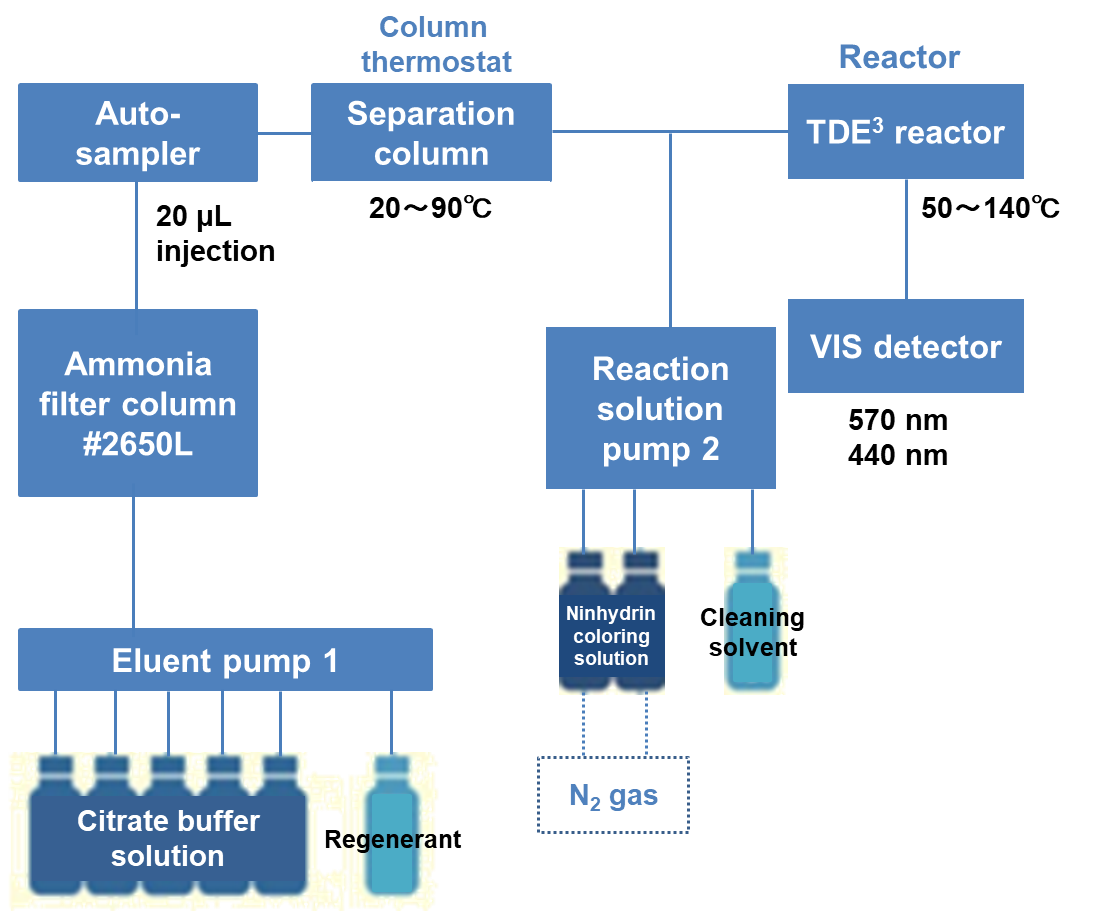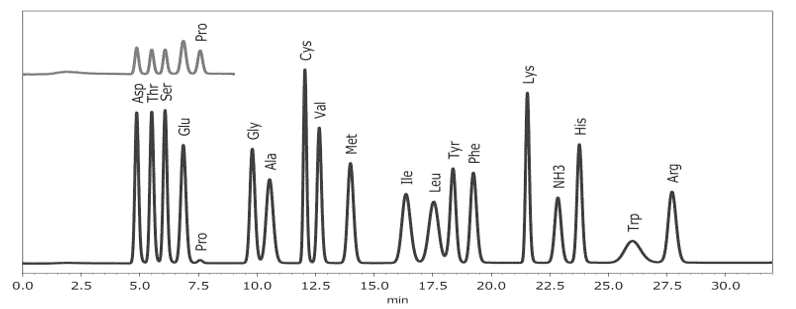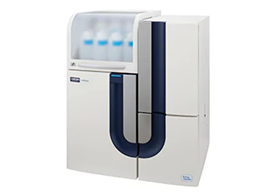Ninhydrin Color Development Method
Amino acids are organic compounds that make up protein, one of the energy-producing nutrients. Amino acid concentrations in the blood (plasma) are precisely controlled, and variations in the amino acid concentration in the physiological fluid are used as indicators of metabolism and disease in the body.
Many amino acid analyses are performed using automated analysis methods. Among these methods, a post-column method, also known as the ninhydrin method, is often used, in which each amino acid is reacted with the ninhydrin derivatization reagent after column separation and absorbance measurement is carried out. In the ninhydrin method, the sample is pressed into an alkaline-cation exchange resin to elute amino acids by increasing the eluent pH in a stepwise manner. However, the preparation of the buffer used (e.g., pH, concentration) is very complicated. FUJIFILM Wako offers a variety of amino acid analysis reagents, such as color-developing test solutions, analytical standards, and buffer solutions for exclusive use with type LA-8080, L-8900, L-8800 (A), and L-8500 (A) high-speed amino acid analyzers manufactured by Hitachi High-Tech Corporation.
Ninhydrin Color Development Method
Ninhydrin reaction is a method to detect and quantify amino acids via ninhydrin coloration.

Amino acids reacted with ninhydrin reaction reagent are detected using two wavelengths, i.e., 570 nm and 440 nm.
The primary amine amino acid (α-amino acid) is colored purple at 570 nm, while the secondary amine (imino acid) amino acid is colored yellow at 440 nm.
Protocol
Methods for amino acid analysis include precolumn derivatization and postcolumn derivatization employed by ninhydrin. Postcolumn derivatization is a method in which a sample is reacted with the derivatization reagent after column separation and transferred to the detector.

Flow diagram of ninhydrin method1)
Measurement Principle
- The sample is pressured into an alkaline-cation exchange resin. When the eluent pH is increased in a stepwise manner, a higher amount of acidic amino acid is eluted early.
- When this eluate is heated after the addition of Ninhydrin Coloring Solution, a colored substance showing the local maximum absorption is produced at 570 nm for α-amino acid and 440 nm for imino acid.
- The peak area of this colored substance is compared with that of the standard solution to determine the concentration of each amino acid in the sample.
- Ito, M. et al. : Wako Jun-yaku Jiho, 86 (3), 15 (2018).
Line Up
| Ninhydrin Coloring Solution | Ninhydrin Coloring Solution Kit for HITACHI Ninhydrin Coloring Solution Kit for JEOL |
| Amino Acid Standard Solutions | Amino Acids Mixture Standard Solution (CRM) Amino Acid Standard Solution |
| Buffer Solution | for High-Speed Amino Acid Analyzer PH/PF Series for Amino Acid Automated Analysis |
Buffer for High-Speed Amino Acid Analyzer PH/PF Series
There are two types of analytical methods for ninhydrin color development: “physiological fluid analysis method” and “protein hydrolysate analysis method”.
PF series of buffers are used for the physiological fluid analysis method, and PH series are buffers for the protein hydrolysate analysis method.
In the ninhydrin method, the sample is pressed into an alkaline-cation exchange resin to elute amino acids by increasing the eluent pH in a stepwise manner. However, the preparation of the buffer used (pH, concentration, etc.) is complicated. These series are buffer solutions prepared based on the user instruction of the Hitachi High-Tech Corporation type LA-8080, L-890, L-8800 (A), and L-8500 (A) high-speed amino acid analyzer. They do not require fine adjustment of concentration or dilution and can be used by setting them directly on the equipment.
The physiological fluid analysis method is an analytical method for 41 amino acids contained in physiological fluids, such as serum and urine, and it can measure special amino acids such as taurine, urea and, glutathione; amines; oligopeptides; and typical amino acids.
The protein hydrolysate analysis method is an analytical method that targets 17 constituent amino acids for proteins, peptides, etc.
Qualitative evaluation of protein and peptide preparations for drugs and composition analysis of amino acids in proteins for foods can be performed.
| Analytical method | About | Buffer Series for High-speed Amino Acid Analysis |
|---|---|---|
| Protein hydrolysate analysis method | An analytical method targeting 17 constituent amino acids of proteins, peptides, etc. | PH series |
| Physiological fluid analysis method | An analytical method targeting 41 amino acids contained in physiological fluids such as serum and urine. | PF series |
Analysis Example
Analysis example using Buffer for High-Speed Amino Acid Analyzer PH-SET
Chromatogram

Analysis conditions
| Device | Model L-8900 Hitachi Amino Acid Analyzer |
|---|---|
| Separation column | Protein hydrolyzate analysis column #2622 4.6 mm ID×60 mm (Hitachi P/N: 855-3506) |
| Ammonia filtering column | Ammonia filtering column #2650L 4.6 mm ID×40 mm (Hitachi P/N: 855-3523) |
| Standard sample | 2 nmol/20μL Amino Acids Mixture Standard Solution, Type H 2 nmol/20μL L-Tryptophan Reference Material |
| Detection | Ninhydrin reaction (Ninhydrin reagent: Ninhydrin Coloring Solution Kit for HITACHI) |
| Measurement wavelength | 570 nm and 440 nm |
| Eluent | Reaction solution | ||||
|---|---|---|---|---|---|
| B1 | PH-1 | B4 | PH-4 | R1 | Ninhydrin solution |
| B2 | PH-2 | B5 | Water | R2 | Buffer |
| B3 | PH-3 | B6 | PH-RG | R3 | 5 vol% Ethanol solution |
| Time (min.) |
%B1 | %B2 | %B3 | %B4 | %B5 | %B6 | Flow 1 (mL/min.) |
Temp. (℃) |
%R1 | %R2 | %R3 | Flow 2 (mL/min.) |
|---|---|---|---|---|---|---|---|---|---|---|---|---|
| 0.0 | 100 | 0 | 0 | 0 | 0 | 0 | 0.400 | 57 | 50 | 50 | 0 | 0.350 |
| 2.5 | 100 | 0 | 0 | 0 | 0 | 0 | ||||||
| 2.6 | 0 | 100 | 0 | 0 | 0 | 0 | ||||||
| 4.5 | 0 | 100 | 0 | 0 | 0 | 0 | ||||||
| 4.6 | 0 | 0 | 100 | 0 | 0 | 0 | ||||||
| 12.8 | 0 | 0 | 100 | 0 | 0 | 0 | ||||||
| 12.9 | 0 | 0 | 0 | 100 | 0 | 0 | ||||||
| 27.0 | 0 | 0 | 0 | 100 | 0 | 0 | ||||||
| 27.1 | 0 | 0 | 0 | 0 | 0 | 100 | ||||||
| 32.0 | 50 | 50 | 0 | |||||||||
| 32.1 | 0 | 0 | 100 | |||||||||
| 33.0 | 0 | 0 | 0 | 0 | 0 | 100 | ||||||
| 33.1 | 0 | 100 | 0 | 0 | 0 | 0 | ||||||
| 34.0 | 0 | 100 | 0 | 0 | 0 | 0 | ||||||
| 34.1 | 100 | 0 | 0 | 0 | 0 | 0 | ||||||
| 37.0 | 0 | 0 | 100 | |||||||||
| 37.1 | 50 | 50 | 0 | |||||||||
| 53.0 | 100 | 0 | 0 | 0 | 0 | 0 |
Analysis example using Buffer for High-Speed Amino Acid Analyzer PF-SET
Chromatogram

Analysis conditions
| Device | Model L-8900 Hitachi Amino Acid Analyzer |
|---|---|
| Separation column | Body fluid analysis column #2622 4.6 mm ID×60 mm (Hitachi P/N: 855-3507) |
| Ammonia filtering column | Ammonia filtering column #2650L 4.6 mm ID×40 mm (Hitachi P/N: 855-3523) |
| Standard sample | Amino Acids Mixture StandardSolution, Type AN/Type B L-2-Aminoadipic Acid Reference Material L-Asparagine Standard Solution L-Tryptophan Reference Material |
| Detection | Ninhydrin reaction (Ninhydrin reagent: Ninhydrin Coloring Solution Kit for HITACHI) |
| Measurement wavelength | 570 nm and 440 nm |
| Eluent | Reaction solution | ||||
|---|---|---|---|---|---|
| B1 | PF-1 | B4 | PF-4 | R1 | Ninhydrin solution |
| B2 | PF-2 | B5 | Water | R2 | Buffer |
| B3 | PF-3 | B6 | PF-RG | R3 | 5 vol% Ethanol solution |
| Time (min.) |
%B1 | %B2 | %B3 | %B4 | %B5 | %B6 | Flow 1 (mL/min.) |
Temp. (℃) |
%R1 | %R2 | %R3 | Flow 2 (mL/min.) |
|---|---|---|---|---|---|---|---|---|---|---|---|---|
| 0.0 | 100 | 0 | 0 | 0 | 0 | 0 | 0.350 | 38 | 50 | 50 | 0 | 0.300 |
| 2.0 | 30 | |||||||||||
| 21.5 | 100 | 0 | 0 | 0 | 0 | 0 | ||||||
| 21.6 | 80 | 20 | 0 | 0 | 0 | 0 | 60 | |||||
| 33.5 | 70 | 30 | 0 | 0 | 0 | 0 | ||||||
| 33.6 | 10 | 90 | 0 | 0 | 0 | 0 | ||||||
| 36.5 | 40 | |||||||||||
| 43.5 | 10 | 90 | 0 | 0 | 0 | 0 | ||||||
| 43.6 | 0 | 100 | 0 | 0 | 0 | 0 | ||||||
| 50.5 | 0 | 100 | 0 | 0 | 0 | 0 | 70 | |||||
| 50.6 | 0 | 0 | 100 | 0 | 0 | 0 | ||||||
| 68.4 | 45 | |||||||||||
| 69.5 | 0 | 0 | 100 | 0 | 0 | 0 | ||||||
| 69.6 | 60 | 0 | 0 | 40 | 0 | 0 | ||||||
| 75.0 | 60 | 0 | 0 | 40 | 0 | 0 | ||||||
| 75.1 | 0 | 0 | 0 | 100 | 0 | 0 | ||||||
| 82.0 | 0 | 0 | 0 | 100 | 0 | 0 | ||||||
| 82.1 | 0 | 20 | 0 | 80 | 0 | 0 | ||||||
| 92.5 | 70 | |||||||||||
| 99.5 | 0 | 20 | 0 | 80 | 0 | 0 | ||||||
| 99.6 | 0 | 0 | 0 | 100 | 0 | 0 | ||||||
| 112.5 | 0 | 0 | 0 | 100 | 0 | 0 | ||||||
| 112.6 | 0 | 0 | 0 | 0 | 0 | 100 | ||||||
| 116.0 | 50 | 50 | 0 | |||||||||
| 116.1 | 0 | 0 | 100 | |||||||||
| 121.5 | 0 | 0 | 0 | 0 | 0 | 100 | ||||||
| 121.6 | 100 | 0 | 0 | 0 | 0 | 0 | ||||||
| 125.0 | 38 | |||||||||||
| 126.0 | 0 | 0 | 100 | |||||||||
| 126.1 | 50 | 50 | 0 | |||||||||
| 148.0 | 100 | 0 | 0 | 0 | 0 | 0 |
Amino Acid Analyzers by Various Manufacturers

Features
- Focuses on operability and safety
In addition to the conventional front access design, the reagent-installing unit set at a height for easier operations facilitates routine reagent replacement, sample setting, and maintenance, thereby minimizing manipulations and operations that require a half-sitting posture (the front door can also be removed). - The long-term reliability and stability of the analyzer have been proved
One can utilize the analysis conditions, column (filler), and reagents that have been established so far.
In addition, unstable ninhydrin reaction reagents usually need to be refrigerated, but for Hitachi amino acid analyzers, refrigeration is not required, since two solutions are mixed immediately before the derivatization reaction. - The analyzer is compatible with diverse applications
Up to six types of buffer solutions and time program for column thermostat can be used.
Moreover, unique features of the reactor, such as high-temperature proof, enable the development of desired methods.
Product Page: HITACHI High-speed Amino Acid Analyzer LA8080 AminoSAAYA
Product List
- Open All
- Close All
Ninhydrin Coloring Solution Kit for Hitachi
Ninhydrin Coloring Solution Kit for JEOL
Amino Acids Mixture Standard Solution (High Range)
Amino Acids Mixture Standard Solution (CRM)
Amino Acid Standard Solution
Buffer Solution for L-8500-PH Series
Buffer Solution for L-8500-PF Series
MCI BUFFER™ PH Series
MCI BUFFER™ PF Series
Buffer Solution
For research use or further manufacturing use only. Not for use in diagnostic procedures.
Product content may differ from the actual image due to minor specification changes etc.
If the revision of product standards and packaging standards has been made, there is a case where the actual product specifications and images are different.
The prices are list prices in Japan.Please contact your local distributor for your retail price in your region.



